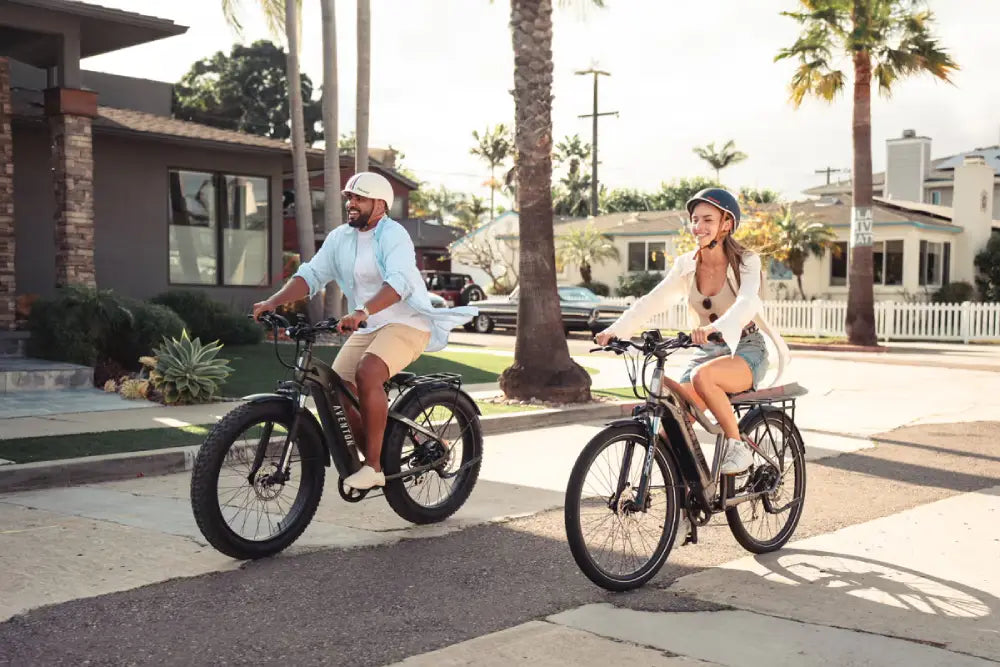
5 Health Benefits of Cycling
July 29, 2022
Maybe you recently thought to yourself ‘Does biking help you lose weight?’ or ‘Is cycling good for weight loss?’ Or maybe a friend, family member, or colleague close to you has started bike riding for weight loss and they can’t stop beaming about how great they feel. Although it is entirely possible to lose weight biking, there are a plethora of added benefits that also come with electric bike riding. More specifically, the physical and mental health benefits that come from biking, which truthfully, far surpass simply just cycling for weight loss. So whether you’re biking for weight loss, commuting, or simply biking for fun, the following is a brief list of some of the many physical and mental health benefits that you may also experience because of your time spent on the saddle!
1. Improvements in Cardiovascular Health
Cycling is an excellent source of cardio. Whether it’s time spent mountain biking off the beaten path, commuting to work on an ebike, or afternoon’s on an aerodynamic road bike, biking can, and will, raise your heart and breathing rates, thus strengthening your heart and lungs over time. In fact, a 2019 review suggests that there is a link between cycling and a lower risk of developing cardiovascular disease. The findings also suggested that a stronger cardiovascular system is associated with lower mortality rates and lower risk for developing other physiological factors such as diabetes, physical limitations, and high blood pressure.
2. Strengthens Lower Body and Core
It should come as no surprise that cycling is excellent for the lower body - glutes, quads, hamstrings, calves, and all - given these muscle groups are all activated when you pedal. For all non-single speed and fixed-gear bicycles, bumping up the resistance will also increase the strain on these muscles, putting you through a more rigorous, yet controlled, workout. According to a 2015 review, regular cycling can build muscle and increase overall strength. Although the review found that building muscle via cycling was not as apparent as muscle built from traditional resistance training, older adults still demonstrated significant gains in strength due to regular cycling.
What you may not realize though is that our legs aren’t the only manual powerhouses when we bike. If you’ve ever felt shoulder, back, or wrist pain when cycling, odds are if the bike wasn’t your right size, your posture was impacting your comfort level. In addition to using your lower body, proper cycling posture also involves activating the muscles in your torso. Engaging our core helps to keep us balanced and avoid hunching far over the handlebars. Thus, also alleviating the pressure you might feel on your wrists! The more you engage these muscles, the stronger they’ll start to feel.
3. Decreases Stress Levels and Reduces Anxiety and Depression
Some of the mental health benefits of cycling include reduced stress levels and ease in feelings of anxiety and depression. According to the American Psychological Association, ongoing research continues to solidify that spending time in nature has a direct link to cognitive benefits, improvements in mood, and promotes a general sense of mental and emotional well-being. For example, observing the road ahead or keeping your cadence when cycling can not only sharpen your cognitive function but can help deepen your awareness of the present moment.
This held especially true for older adults who used electric bikes as their form of cycling, as a 2019 study found; While both pedal bicycles and e-bikes enabled older adults to increase their physical activity levels, electric bikes provided greater benefits as they could travel longer distances without worrying about returning home, cover a greater distance in less time, cope with physical ailments that otherwise would make cycling challenging or impossible, and feel encouraged to cycle more frequently and for longer. The study also found improvements in cognitive function and well-being via cycling: increased older adults’ sense of independence and mobility and reduced their feelings of isolation and depression.
4. Reduces and Prevents the Risk of Developing Other Diseases
As we briefly discussed in Improvements in Cardiovascular Health, regular cycling can help reduce, prevent, or manage other diseases, such as diabetes and high blood pressure. A 2017 study, carried out by Glasgow researchers, discovered groundbreaking evidence that bicycle commuting, similar to recreational commuting, was associated with a lower risk of developing cardiovascular disease, cancer, and even preventing premature death. Following 260,000 UK citizens over the span of 5 years, researchers discovered the participants who regularly commuted by bicycle - an average of roughly 30 miles a week - reduced their risk of developing cancer by 45%, heart disease by 46%, and risk of sudden death by 41%.
While cycling can help reduce our risk and potentially prevent the development of disease, it also can be instrumental in disease management. Janah Trent, a stage 4 Ovarian Cancer fighter and survivor, was the epitome of an outdoorsy adventurer before her diagnosis: hiking 4,000-foot mountains, biking 40+ miles on the weekends, and having a mind that was determined to cross experiences off her list. She shared with us how her Aventon ebike made a monumental difference in her cancer recovery, allowing her to no longer have her mind flooded with thoughts that her body isn’t able to get out into the great outdoors and still bike. Although her physical body doesn’t have the same capabilities as before her diagnosis, her electric bike allows her to still show up and rack up miles on her ebike’s saddle!
5. Weight Loss
For those that found this article wondering, ‘Is biking good for weight loss?’, we’re closing out our brief list with the last benefit: biking to lose weight! Cycling is one of the best forms of low-impact cardio; It allows riders to get their heart rate up without as much strain on their knees, ankles, or other joints as they would when running or jogging. Additionally, when they’re pedaling beyond a leisurely pace, cycling is also a great way to lose unwanted or excess weight. Research even suggests that electric bike riders slightly overshine pedal bike cyclists in total amounts of exercise each week! So if you’re someone who’s thought ‘Does biking help you lose weight?’, here are a few strategies to help jumpstart your weight loss through cycling.
Start Slow
Sustainability is one of the keys to weight loss for good. If you’re just starting out, jumping back into the saddle after some time, or even beginning to stay active after an injury or due to limited mobility, the best thing to do when beginning cycling to lose weight is to start slow. Don’t overwhelm yourself or your body with vigorous activity if you’ve been fairly inactive leading up to it. Whether this means starting out cycling for 10-15 minutes every day or even 2 - 3 times a week, recognize where you’re beginning from, honor your needs, and discover how starting slow feels right for you!
Work to Push Your Comfort Zone by Going Further
As you start to build your confidence in the saddle and increase your stamina when cycling, try to push past your usual routine or maximum miles and go a little further. If you started out cycling for 10-15 minutes every day, start to slowly add a few more minutes to each session. Alternatively, if you’re cycling 2 - 3 times a week, try gradually adding another day in increments over the span of weeks. The end goal should be 150 minutes of moderate-intensity physical activity per week.
Increase Your Intensity
Leisurely pedaling or relying entirely on the electric part of your bike likely won’t do much for weight loss, but if you gradually increase the intensity of your pedaling efforts, you might start to see some weight loss wins. The general rule of thumb is, that the faster you cycle, the more calories you’ll burn. The higher your intensity, whether that’s increasing your resistance or pushing yourself to pedal faster, even more calories you burn. Our bodies require energy to pedal faster and harder, so the more calories you burn biking, the closer you might get to your weight loss goals!
Consider High-Intensity Interval Training (HIIT)
High-intensity interval training (HIIT) consists of short bursts of intense exercise balanced with intervals of low-intensity exercise. HIIT activities are not only a great way to challenge your body and strengthen your mind, but can also aid in weight loss! A HIIT* activity when cycling can look something like this:
-
- For 30 - 60 seconds, pedal as fast as you’re able to against a high resistance: shift into a high gear (or a smaller cog) that feels most comfortable for you and your abilities.
- Follow with 2 - 3 minutes of easy cycling on a lower resistance level: shift into a lower gear (or higher cog) that feels most comfortable for you.
- Repeat this pattern for roughly 20 - 30 minutes, or until you feel like you’ve hit your maximum!
*HIIT exercises will be more taxing on the body than recreational and leisurely activities, so only attempt this form of aerobic activity after consulting with your doctor or if you’re already leading an active lifestyle.
To Close
At the end of the day, regardless of if you’re cycling to lose weight, to commute, or to spend time in nature with friends or family, the health benefits of biking are plentiful and apply to everyone, despite their intent. So, consider this your friendly reminder to gear up and get to biking this week! You never know how your actions and efforts in the saddle might impact your physical health and mental wellness and happiness today and later on down the road.






Yah, All sounds good.👌🏻 I ordered a Aventure can’t for it to get here.
I am 67 years old and have moderate to occasionally severe knee pain. I bought my Aventure a few months ago for my 10 mile round trip commute intending to use throttle mode only. Somehow I convinced myself to settle into a commute that uses high gear and pedal assist level three. It provides a modest amount of pedal resistance.
I did not buy my Aventure for health reasons however my knees feel great! I haven’t had pain for a month!!!
My Adventure is my second Aventon bike. I bought a Pace 500 first and really liked the style and function of that bike, riding it over 800 miles. Earlier this year I saw an add for the Adventure, watched YouTube videos comparing it to like bikes and the Adventure always came out on top. I decided it would open up a lot of areas I would not feel comfortable riding my Pace. Great decision buying the bike. It’s a beast, well made and designed. In four months I have over 1000 miles on it. I’m 74 and try to ride 20+ miles a day, weather permitting.